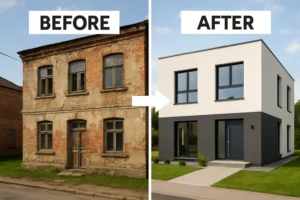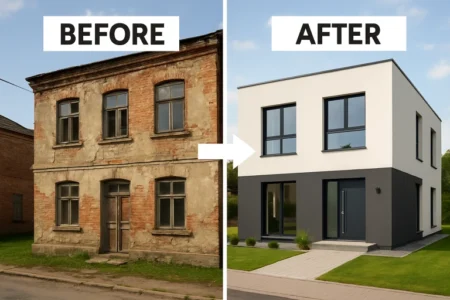In the ever-evolving landscape of the architectural world, the intersection of traditional craftsmanship and cutting-edge digital technologies has given rise to a new era in design and construction. This transformation is not merely a trend; it’s a fundamental shift that architects must navigate to thrive in the digital age. The marriage of architecture and technology is more than a collaboration—it’s a revolution that has the power to reshape the way architects approach their craft.
The Architectural Revolution: Embracing the Digital Age
What Does “Architectural” Mean in the Digital Age?
In the digital age, the term “architectural” transcends the physical structures we see around us. It encompasses a realm where traditional methods seamlessly integrate with digital tools, creating a dynamic landscape for architectural design. Architects are no longer confined to drafting tables and physical models; instead, they harness the power of 3D modeling, virtual reality (VR), and augmented reality (AR) to envision and refine their creations.
The design process, once reliant on manual labor, is now optimized through the use of Building Information Modeling (BIM). This digital representation of building components enables architects to collaborate more efficiently, make data-driven decisions, and ultimately create more sustainable and innovative designs.
The Architect’s Role in the Digital Fabrication Age
As the architectural industry embraces digital technologies, the role of the architect is undergoing a profound transformation. Architects are no longer mere designers; they are facilitators of a digital revolution that is reshaping the built environment. The use of digital fabrication technologies allows architects to bring their visions to life with unprecedented precision and efficiency.
The intersection of technology and architectural design is not just about adopting new tools; it’s about revolutionizing the way architects think and work. The architect of today must be adept at computational design, artificial intelligence (AI), and immersive technologies to stay ahead in an industry that is evolving at an unprecedented pace.
Navigating the Digital Landscape: Key Trends and Technologies
Virtual Reality in Architectural Design
In the realm of architectural design, virtual reality (VR) stands out as a transformative technology. VR allows architects to immerse themselves and their clients in virtual environments, providing a realistic preview of the proposed designs. This not only enhances the design process but also facilitates better communication and understanding among stakeholders.
The use of VR in architecture goes beyond visualization; it enables architects to explore different design possibilities and iterate rapidly. This technology is a game-changer in client presentations, as it allows them to experience spaces before they are built, fostering a deeper appreciation for the design concepts.
Digital Technologies and 3D Modeling in Architectural Practice
3D modeling has become a cornerstone of architectural practice in the digital age. Traditional methods of architectural representation are being replaced by sophisticated digital tools that allow architects to create intricate and detailed models. This shift not only expedites the design process but also opens up new possibilities for exploring complex geometries and innovative forms.
The use of 3D modeling in architecture extends beyond design; it plays a crucial role in the communication of ideas. Architects can create digital prototypes, enabling them to test and refine their designs before they are physically realized. This iterative process enhances the overall quality of architectural projects and contributes to a more efficient and sustainable construction phase.
Revolutionizing Construction Projects: The Impact of Digital Fabrication
Digital fabrication is revolutionizing the way buildings are constructed. From 3D printing technology to robotic construction techniques, architects now have a myriad of tools at their disposal to optimize the construction process. This not only accelerates project timelines but also enhances the precision and quality of the built environment.
The integration of digital fabrication in construction projects extends to building performance optimization. Architects can leverage data and technology to design structures that are not only aesthetically pleasing but also energy-efficient and environmentally sustainable. This shift towards a more holistic approach to design and construction aligns with the growing emphasis on sustainability in the architectural industry.
Looking Ahead: The Future of Architecture in the Digital World
Computational Design and the Architectural Landscape
As we navigate the digital age, computational design emerges as a driving force in architectural innovation. This approach involves using algorithms and parametric modeling to generate and optimize design solutions. Architects can harness the power of computational design to explore a vast array of possibilities, pushing the boundaries of traditional architectural thinking.
The future of architecture lies in the hands of those who can seamlessly integrate the capabilities of technology with the creativity of design. Computational design not only enhances the efficiency of the design process but also enables architects to respond to complex challenges with innovative and data-driven solutions.
The Role of Artificial Intelligence in Architectural Practice
Artificial intelligence (AI) is making significant contributions to architectural practice. From automating repetitive tasks to analyzing complex datasets, AI empowers architects to focus on the creative aspects of their work. Machine learning algorithms can assist in the design process by generating insights based on historical data, allowing architects to make informed decisions and optimize their designs.
The intersection of AI and architecture is not about replacing human creativity; rather, it’s about augmenting the capabilities of architects. As AI continues to evolve, architects will find themselves collaborating with intelligent systems that enhance their problem-solving abilities and contribute to the overall efficiency of the design and construction process.
Embracing Change: The Digital Revolution in Architectural Practice
As we stand at the intersection of architectural design and digital technologies, it’s evident that the landscape of the architectural industry is undergoing a profound transformation. The application of digital tools, virtual environments, and innovative technologies is not just a trend but a paradigm shift that is redefining the way architects approach their craft.
Architects must embrace this digital revolution, not as a challenge, but as an opportunity to redefine the future of architecture. The integration of technology is not a departure from the essence of architectural practice; instead, it’s a natural evolution that enables architects to expand their creativity, optimize their processes, and contribute to a more sustainable and technologically advanced built environment.
In conclusion, the intersection of architectural design and digital technologies is a journey into uncharted territory, where the possibilities are as vast as the digital landscape itself. As architects navigate this evolving terrain, they must embrace the fusion of creativity and technology, unlocking new dimensions in design, construction, and the overall shaping of the built environment. The digital age is not a threat to the traditional principles of architecture; rather, it is a catalyst for innovation and a gateway to a future where the boundaries of architectural imagination are boundless.
FAQs
What is the relationship between building technology and architecture?
The relationship between building technology and architecture is symbiotic. Architects leverage new technology to push the boundaries of design, integrating digital tools and methods into traditional processes. This fusion allows architects to optimize the construction phase, enhance sustainability, and respond to evolving needs in the architecture industry.
How is building and architecture related to technology?
Building and architecture are intricately related to technology, especially in the digital age. The use of technology in architectural design, from computer-aided design to virtual reality, has revolutionized the field. Architects employ new technology not as a departure from traditional methods but as a means to amplify their creativity and efficiency in the design and engineering processes.
How would you explain the connection of technology with architecture?
The connection of technology with architecture is transformative. Architects navigate a dynamic field where technology advances continuously. From the Industrial Revolution to the present, architects employ new technology to optimize project delivery, enhance design strategies, and explore innovative design options, shaping the future trends and architectural forms in the field of architecture.
What is the use of digital technology in architecture?
Digital technology in architecture goes beyond mere tools; it is a catalyst for innovation. Architects use digital design, virtual reality (VR), and augmented reality (AR) to revolutionize design processes. The field of architecture embraces technologies like BIM, creating digital platforms for collaborative design models. This use of technology not only improves project delivery but also opens up new possibilities and design options for architects.
What is the purpose of technology architecture?
The purpose of technology architecture is to facilitate the seamless integration of technology in architectural processes. It encompasses the use of digital platforms, design software, and new technologies to optimize project delivery. In the architecture industry, technology architecture plays a crucial role in shaping smart buildings, exploring possible futures, and staying at the forefront of technological advancements.
What are examples of technology architecture?
Examples of technology architecture include the incorporation of VR and AR in architectural services. Architects use these technologies to create immersive designs, enhancing the way architects design and deliver projects. Additionally, the integration of new software and digital platforms exemplifies the practical application of technology architecture in the field of architecture.
What are the positive effects of technology on architecture?
The positive effects of technology on architecture are manifold. The use of technology enhances the way architects design, fostering a future where designs are based on specific, data-driven insights. Technological advancements not only optimize project delivery but also enable architects to explore new knowledge and ideas. Studies have been conducted to highlight the positive impact of technology on architectural concepts, opening doors to innovative designs and sustainable architectural processes.
In summary
The marriage of architecture and technology is a dynamic process where architects, using new technology, shape the future trends in the field. The positive effects are evident in the optimization of design and engineering processes, the creation of smart buildings, and the exploration of innovative design options—all of which contribute to the evolution of the architecture industry.





